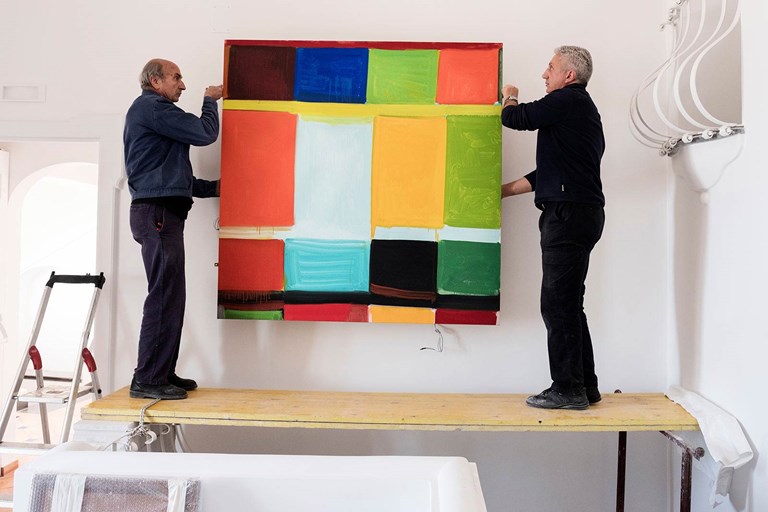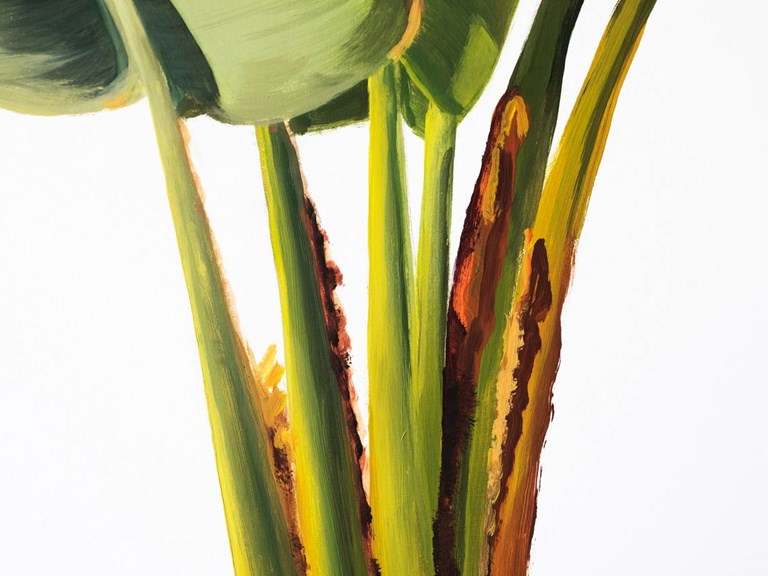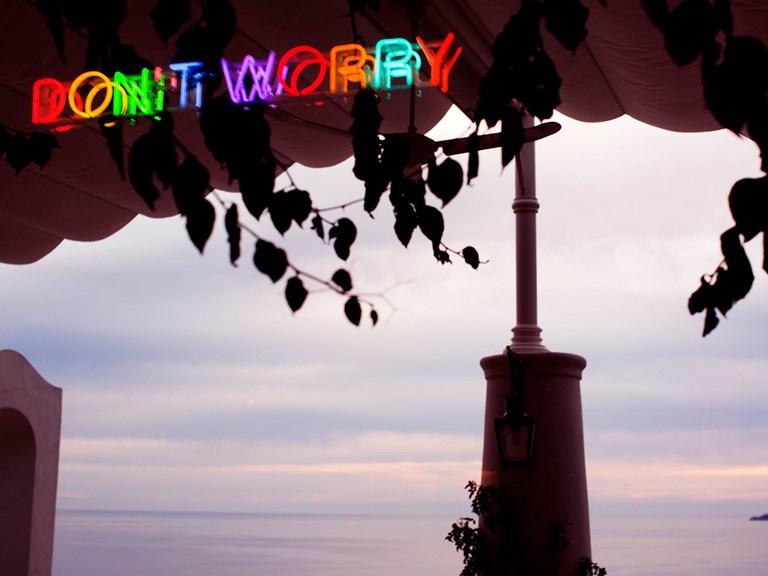STANLEY WHITNEY: DANCING THE JITTERBUG WALTZ
03.05.2017 ART & CULTURE
The large work that dominates the trio is called The Jitterbug Waltz. It’s an apt title: together with its smaller but no less lively siblings, it dances and vibrates with colour in the cool white setting – one of the fourth-floor guest salons that formed the original nucleus of the family house around which Le Sirenuse hotel was built.
It would be wrong to describe Whitney as a late bloomer; it’s just that it’s taken the art world a while to catch up with the Philadelphia-born artist, who celebrated his 70th birthday in 2016.
It has really only been in the last five years that Whitney has achieved serious recognition in his homeland, a reappraisal that culminated in a major solo show, ‘Dance the Orange’, at the Studio Museum in Harlem, New York, in 2015. More recently, Whitney was one of only a handful of painters selected for the 2017 edition of prestigious five-yearly art event documenta, which in its 14th edition spread from its historic base of Kassel in Germany to the Greek capital, Athens.
Previously, the abstract painter celebrated for his vivid colour-field canvases was better known in Europe, where he has also lived and taught for long periods (he and his wife, the artist Marina Adams, have a studio space in Parma). In a 2013 interview with bomb magazine, the painter suggested that this might be because his ‘old-fashioned’ focus on painting, and by extension drawing, is taken more seriously on the Italian side of the Atlantic: “I think New York is really Warhol’s town; Pop is just bigger here. In Europe, they have a sense of what abstraction is. They have a real sense of painting”.
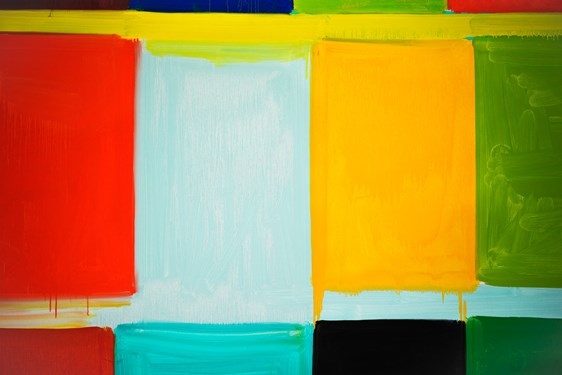
View
It’s easy to describe a Whitney, but not so easy to describe what it does. For decades, after an early art-school phase in which “I was coming from made-up, figurative work where I’d paint self-portraits and things out of Goya or Velázquez”, Whitney has focused on painting blocks of colour on square canvases. These blocks are divided by horizontal bands, between three and five in each work. The result is a dance of colour that seems to cleave to certain rules but at the same time to challenge or flaunt those rules.
The colour blocks are not all the same size, even within the row; the horizontal bands are not evenly spaced. Some of the paint has been thickly and evenly laid on, but in other cases only a first coat seems to have been applied, and the brushstrokes are clearly visible. Sometimes paint drips down from one of the colour squares onto the horizontal bands. And the square canvas seems to struggle to contain the whole work: certain colour-blocks appear truncated, or barely have time to start at the edge of the painting, as if the work were a sample of fabric cut from a much larger bolt of cloth. It’s tempting to relate this to a comment Whitney let drop in that bomb interview: “I always want to have every colour of the universe in the painting”. Could it be that all the artist’s paintings are, rather like those disassembled Renaissance altarpiece fragments one sees in museums, merely details of some ideal infinite work in which all the colours in the universe are present?
In a review of the artist’s Studio Museum show, New Yorker art critic Peter Schjeldahl described the ‘Whitney effect’ thus: “The glamour of the work alerts you to an onset of beauty, pending the appropriate feeling and an endorsement in thought. But the juxtapositions and the compositional rhythms of the colors, jarring ever so slightly, won’t resolve into unity. What’s going on? Does the artist aim at order and miss, or does he try, and fail, to destroy it?”.
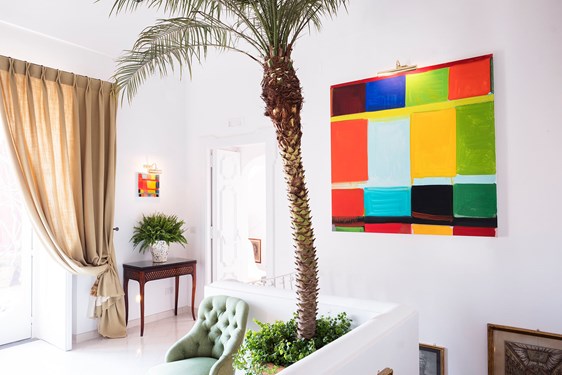
View
It’s no surprise that jazz metaphors are sometimes reached for in discussions of Whitney’s work: jazz is a form that enacts the same tension between rules and defiance, rhythmic order and creative displacement. Whitney has talked about the influence of Ornette Coleman and Charlie Parker on his work: “When I first saw Cézanne, I thought, This is like Charlie Parker, only painting. It’s like polyrhythm, a beat and a beat and a beat and a beat, like call and response, you know— in the middle of the beat there’s another beat. Cézanne was key and a big source for me. Going back and forth—the music, the color, the rhythm, the beat”. The Jitterbug Waltz, the title of Whitney's Artists at Le Sirenuse commission, takes its title from Fats Waller’s celebrated 1942 instrumental of the same name, unusual both in its 3/4 waltz time signature and in Waller’s choice of the Hammond organ rather than his more usual piano. It’s a piece of odd musical angles, jaunty discords and resolutions, much like Whitney’s suite of paintings.
When Whitney talks about the colour in his paintings, the challenges he sets himself can sound rather abstract and technical. “How could I lay two colors so close to each other and not trap them but rather allow air for the canvas to breathe?”, he once rhetorically asked himself in an interview with Artforum. “This became a sort of preoccupation for me. Creating space within color involves experiments with density, vibrancy, saturation, and even with matteness”.
Yet it is clear that for this Afro-American artist, whose parents could not even enter a museum because of the colour of their skin, this endeavour is not a dry conceptual exercise. The arrangement of colour fields on a square canvas measuring 4 feet by 4 feet is a creative act, but also a political one. “The idea”, Whitney has said, “is that color cannot be controlled and that it has total freedom. One color can’t overpower another color. It’s a very democratic idea, very New York”.
Photo © Roberto Salomone
Le Sirenuse Newsletter
Stay up to date
Sign up to our newsletter for regular updates on Amalfi Coast stories, events, recipes and glorious sunsets
